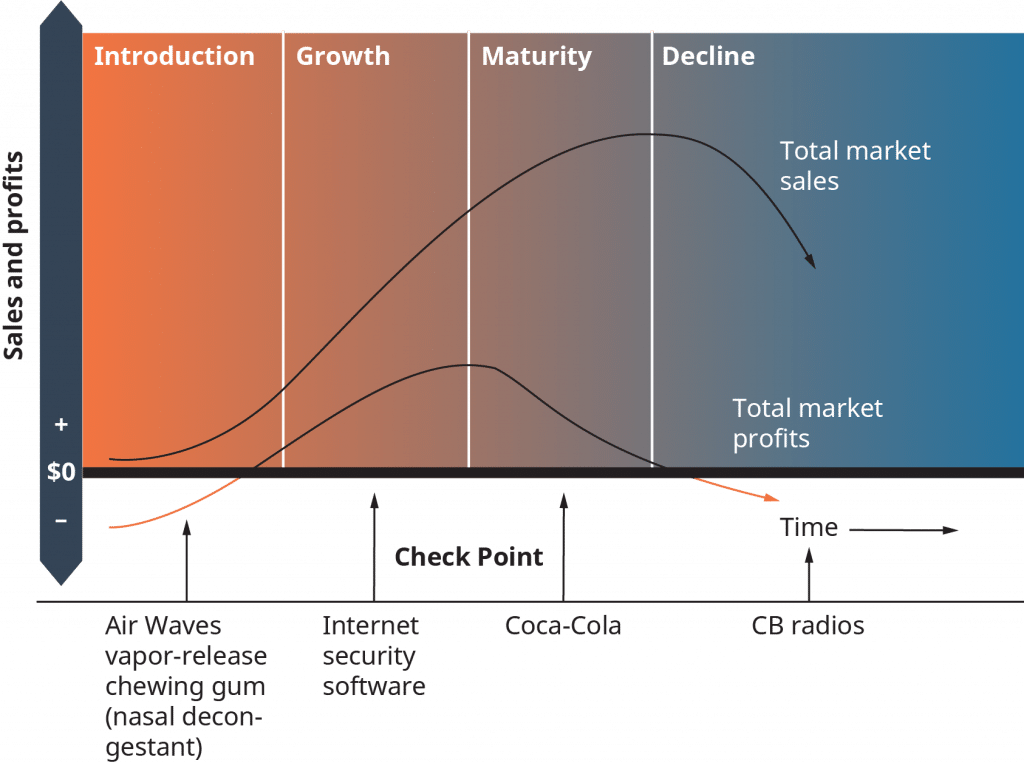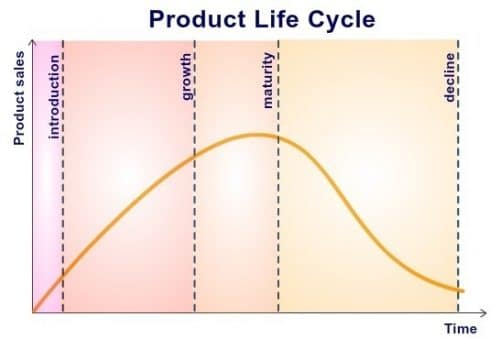Every product has a shelf life, whether it is one week or ten years. Businesses can make better judgments if they have a better understanding of a product’s lifespan. Product Life Cycle Theory refers to the stages of a product’s life cycle. In this post, we will define the Product Life Cycle Theory, as well as discuss the stages and present some real-world examples.
What is the Product Life Cycle Theory?
Raymond Vernon established the Product Life Cycle Theory as a marketing approach in 1966. It is still frequently used today to assist businesses in planning the progression of their new goods. The Product Life Cycle Theory highlights the stages that every product goes through.
The Product Life Cycle Theory has four stages. The length of each stage varies by product, with some requiring only a day and others needing months or years. Many factors influence how rapidly a product moves through the four stages, including how they market the product, the product’s demand, and the product itself.
Product Life Cycle Theory Stages
The Product Life Cycle Theory has four stages:
- Introduction
- Growth
- Maturity
- Decline
#1. Introduction
A company is ready to begin the product life cycle after completing research and producing a product. The introduction phase occurs when a company successfully launches a new product into the market. During this stage, the company conducts research to determine consumer demand and promotes the new product.
Because potential buyers are still learning about the product, businesses should expect sales to below during the introduction stage. This could alter if the company generates significant anticipation before the debut.
Businesses should invest effort at this level educating clients about the brand and product. This is also the time to evaluate distribution channels and figure out how to sell the product most effectively. Businesses should also expect less rivalry during this phase because competitors have not yet sought to imitate or improve on their products.
#2. Growth
The following stage occurs when the product’s demand begins to rise. It eventually results in more sales, which leads to more profit. During the growth stage, the product’s popularity grows and competitors begin to take notice. As competitors try to siphon off part of their sales, businesses may begin to see identical products released into the market.
Investing in marketing and promotion is critical at this stage to attract as many clients as possible. Because enthusiasm is still rising and there is still relatively little competition, this is often the phase in which enterprises see the largest sales of their product.
#3. Maturity
The product enters the maturity phase when it is widely known and purchased by a large number of customers. Businesses must work hard during this stage to keep their product relevant as competition grows. They spend money to keep the product at the top of the market and prevent sales from declining.
Saturation might be a problem throughout the maturation stage. As the industry grows saturated, consumers now have multiple competitors to select from. Marketing teams must devote time to distinguishing their goods from competitors and increasing brand recognition. Companies should improve customer service alternatives during this time period to help with the increasing number of clients.
Customers wishing to replace their product with something new is another problem in the maturity period. Even though the product is still functional, they may choose to upgrade to something with more advanced features. As a result, firms must devote significant resources to marketing to increase sales as much as feasible.
#4. Decline
When no amount of marketing or promotion can keep a product’s sales from dropping, it reaches this stage. This stage may occur spontaneously as buyers lose interest in an older product, or it may occur as a result of competitors outperforming the product in terms of features or price.
During the decline period, the company may still sell the product. Sales will most likely continue until the cost of producing the product exceeds the revenues made by it. Furthermore, rather than relying primarily on one product that is now in decline, many organizations have numerous goods on the market, each at a distinct stage of the product life cycle.
It is possible to keep a product from entering the decline stage, at least temporarily, but this needs the product to become a preferred marketplace choice.
Examples showing the Product Life Cycle Theory

Here are a few examples that show how the product life cycle works:
#1. VCRs
A video cassette recorder (VCR) is a device that records and plays back video on a television. These devices were formerly quite popular, but sales have dropped dramatically due to the introduction of more technologically advanced goods. A VCR’s product life cycle might look like this:
- Introduction: In 1977, the VCR was released for the first time. It was a novel gadget that allowed the video to be played back on television displays. Users might also record and revisit their favorite TV programs.
- Growth: Sales grew as more people became aware of the VCR. Eventually, several firms began to manufacture their own VCRs.
- Maturity: The videocassette recorder (VCR) became a common household device. Producers have to discover ways to cut costs while adding functionality to maintain selling VCRs.
- Decline: VCRs grew less popular as technology advanced. Streaming services are now used by the majority of households to watch content.
#2. Smartphones
Every couple of months, a new smartphone model is produced as suppliers strive to outperform their competition. A typical product life cycle for a new smartphone device is as follows:
- Introduction: The new smartphone has been released to the market. Because prior generations of this technology have been released, there is a lot of excitement. As a result, sales begin immediately upon product launch, propelling the product into the growth stage.
- Growth: Demand for the latest smartphone continues to climb as more people begin to use it. Competitors research its latest features and begin developing their own devices that can outperform this model.
- Maturity: The smartphone has lost some of the original fervor that greeted its release, and sales have plateaued. Customers continue to purchase the product, but they are increasingly considering alternatives. New features in this smartphone are now standard in other models, making this device stand out less.
- Decline: Eventually, this newest smartphone model will be considered obsolete. Consumers seek the most recent model because competition has discovered a way to manufacture a superior product. The original phone’s manufacturer may have even released a newer version of their device, which has now replaced it in the market. The company will continue to offer its older model until demand is completely depleted.
The International Product Life Cycle Theory’s Three Stages
Raymond Vernon developed the International Product Life Cycle Theory in the 1960s to explain the cycle that products go through when exposed to an international market. As a result of internationalization, the cycle depicts how a product matures and declines. Within the theory, there are three stages.
#1. Introduction of a New Product
The cycle always starts with the launch of a new product. A corporation in a developed country will invent a new product at this stage. As a result, the market for this product will be small, and sales will be poor. Vernon inferred that innovative items are more likely to be generated in developed countries because consumers have more discretionary cash to spend on new things when the economy is doing well.
To mitigate the impact of poor sales, firms will keep the product’s manufacturing local, so that if process issues develop or a need to adapt the product in its early stages arises, modifications can be done without too much risk or wasting time.
As sales grow, firms may begin to export the product to other developed countries to enhance sales and revenue. It is a simple step toward internationalizing a product because people’s appetites in industrialized countries tend to be relatively similar.
#2. The Maturity Stage
When the product has firmly established demand in developed countries, the producer will need to consider opening production operations locally in each developed country to supply the demand. Because the product is manufactured locally, labor and export costs will fall, lowering the unit cost and increasing revenue. Product development can still take place at this stage because there is still room to adapt and adjust the product if necessary. In this stage, developed-country appetites for the product will continue to rise.
Although the unit costs have been reduced as a result of the decision to manufacture the goods locally, the product will still require a highly skilled labor force to be manufactured. Local rivalry to provide alternatives begins to emerge. Increased product exposure begins to reach countries with less developed economies, and demand from these countries continues to build.
#3. Manufacturing Streamlining and Product Standardization
Exports to less developed economies begin in earnest. The competitive product offers saturate the market, causing the original purveyor of the product to lose its competitive edge based on innovation. As a result, rather than continuing to add new features to the product, the firm focuses on lowering the cost of the manufacturing process. They accomplish this by shifting production to countries with lower average incomes and standardizing and streamlining the industrial processes required to create the product.
Local labor in lower-income countries is then exposed to the technology and procedures used to manufacture the product, and competition begins to rise, as it did previously in affluent countries. Meanwhile, as a new product captures the attention of the people, demand in the original country where the product originated begins to diminish and finally dwindles. The market for the product is now completely saturated, so the global business discontinues production in low-income countries and instead focuses on new product development as it gracefully exits the market.
What remains of the market share is divided among primarily foreign competitors, and consumers in the original country who desire the product at this point will most likely buy an imported version of the product from a country with lower incomes. The cycle then begins anew.
How can businesses ensure successful management of the Product Life Cycle Theory?
The management of the Product Life Cycle Theory is crucial for businesses, as it can help them to understand the different stages a product goes through and make informed decisions to maximize profits and minimize losses. By keeping an eye on the product life cycle and being prepared for each stage, businesses can successfully manage their products from introduction to decline.
What is the relationship between the Product Life Cycle Theory and market share?
The relationship between the Product Life Cycle Theory and market share is an important one. As a product progresses through its life cycle, market share can increase or decrease, which can have a significant impact on a business’s profits and overall success. Understanding this relationship is crucial for businesses that want to make informed decisions about their products and the market.
Can the Product Life Cycle Theory be used for new product development?
Definitely! In fact, the Product Life Cycle Theory can be a valuable tool for new product development. By understanding the different stages a product will go through, businesses can make informed decisions about the development, marketing, and positioning of new products to ensure their success.
How can businesses assess the life cycle stage of their products?
Businesses can assess the life cycle stage of their products by considering factors such as sales trends, market saturation, and competitor activity. By analyzing these factors and making informed decisions, businesses can accurately determine the stage their products are in and make plans for the future accordingly.
How can businesses prepare for the decline stage of the Product Life Cycle Theory?
Preparing for the decline stage of the Product Life Cycle Theory can involve a number of strategies, such as diversifying into new markets, rebranding, or repositioning the product. By being proactive and making informed decisions, businesses can minimize the impact of the decline stage and ensure the continued success of their products.






